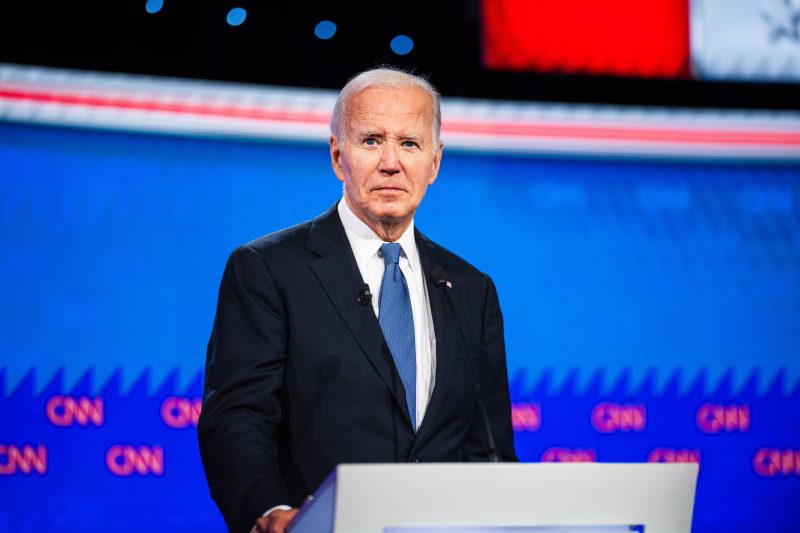
There are an enormous number of questions lingering around the presidential race at the moment, nearly all centered on President Biden and nearly all of them downstream from his remarkably poor performance in last week’s debate.
The most obvious is whether Biden will drop out, allowing his party to nominate someone else as its candidate to run against Donald Trump in November. That question is different from but linked to the more urgent, unresolved question: Is Biden able to handle the job of the presidency now, much less in a year’s time?
Those questions are of central importance for the country but, in the cold calculus of politics, secondary for his party. Instead, Democrats are trying to figure out whether Biden might still be able to beat Trump despite the debate — or, more accurately, despite the debate’s reinforcement of questions about Biden’s age. Secondarily, the party is trying to figure out which Democrat might have a better shot at beating Trump. If Biden’s going to be replaced, the purpose would obviously be to demonstrably improve the party’s chances.
But such questions are very hard to answer. It is hard to know who might be better positioned than Biden against Trump both because Biden and Trump are still relatively close in polling and because it’s very hard to predict how a campaign will unfold with a new candidate suddenly thrust into the spotlight. Vice President Harris runs better than Biden and other oft-mentioned Democrats in CNN’s poll this week, but only subtly relative to margins of error. It’s simply impossible to say. So the party’s running on emotion more than anything — in part because of the lingering shock of the debate.
Here’s what we can say: The debate did not improve Biden’s chances. There are only so many events in a presidential campaign where candidates can count on an enormous amount of attention. Debates are among them. Biden came into this one running about even with Trump and needed to pull ahead. He didn’t, though it’s not entirely clear the extent to which he might have faltered.
We can also say that the poll that plays perhaps the most outsize role in the consciousness of Democratic elected officials and activists suggests that Biden lost ground. That’s the one from the New York Times and Siena College, a poll that thanks to the prominence of its sponsor, often drives discussion of the state of the race on the left.
The Times polled Americans before and after the debate, allowing us to see how things have changed. Among likely voters, that change was subtle: Trump led by four points before the debate and leads by six points now. Not a statistically significant shift — but also not a shift that suggests Biden accomplished what he needed to.
We can also dip into the poll to get a sense of what that shift might have looked like among certain voting blocs. We see, for example, a big shift among men (highlighted in the Times’ report on the poll), Hispanic Americans and among younger voters toward Trump. There was a big shift the other way among Black Americans.
But there are caveats to apply here. First, that the polls included smaller numbers of Black and Hispanic respondents, so the margins of error are higher.
More importantly, the numbers after the debate among men, young voters and Black voters look a lot like the numbers from the Times’s April poll. Then, men preferred Trump by 20 points compared to 23 points now. Black voters preferred Biden by 60 points; now it’s 65. Young voters preferred Biden by two points then and three points now. Views of the candidates among Hispanic voters, by contrast, did not revert to where they were three months ago.
The central question raised by the debate was whether views of Biden’s fitness to serve as president had changed. They did, again heavily among the groups identified above. Now a majority of Hispanic voters say that Biden’s age is such a problem that he can’t perform the job capably. So do men.
I should note, just to put some money on the table here, that I think another candidate would likely fare better against Trump. (Harris, for example, does better with young voters and voters of color, among whom Biden does unusually poorly.) I also think that it’s unlikely Biden beats Trump at this point, particularly given the role of the electoral college (which we’ll get to in a second). But I also admit that the numbers above don’t reinforce any of those assumptions concretely.
Besides, I offered a warning last week about relying too heavily on one poll. That warning stands, however appealing it might be to dig deep into that poll like an augur presented with a pile of animal entrails. So let’s instead look at 538′s average of polling nationally and in the five states that swung to Biden in 2020.
The vertical axis here is intentionally compressed to show movement. Which it does.
Since the debate, Trump’s widened his lead to about two percentage points. Since 538′s state-level averages are derived in part from the national average (since national shifts tend to trickle down to states), Biden’s lost ground across all five states in those averages. But, then, those shifts mirror those seen after the first debates in 2012 and 2020.
There is lots of evidence by now that the debate made the Democratic position worse even if, as the most hopelessly optimistic Dem might offer, it’s only because the debate didn’t help the incumbent president gain traction. Unfortunately for scrambling Democrats, the polls don’t do much to answer the questions above, whether Biden can’t beat Trump or which Democrat might be better positioned to do so.
The party is barreling toward what appears to be a cliff and can’t see over the edge.














